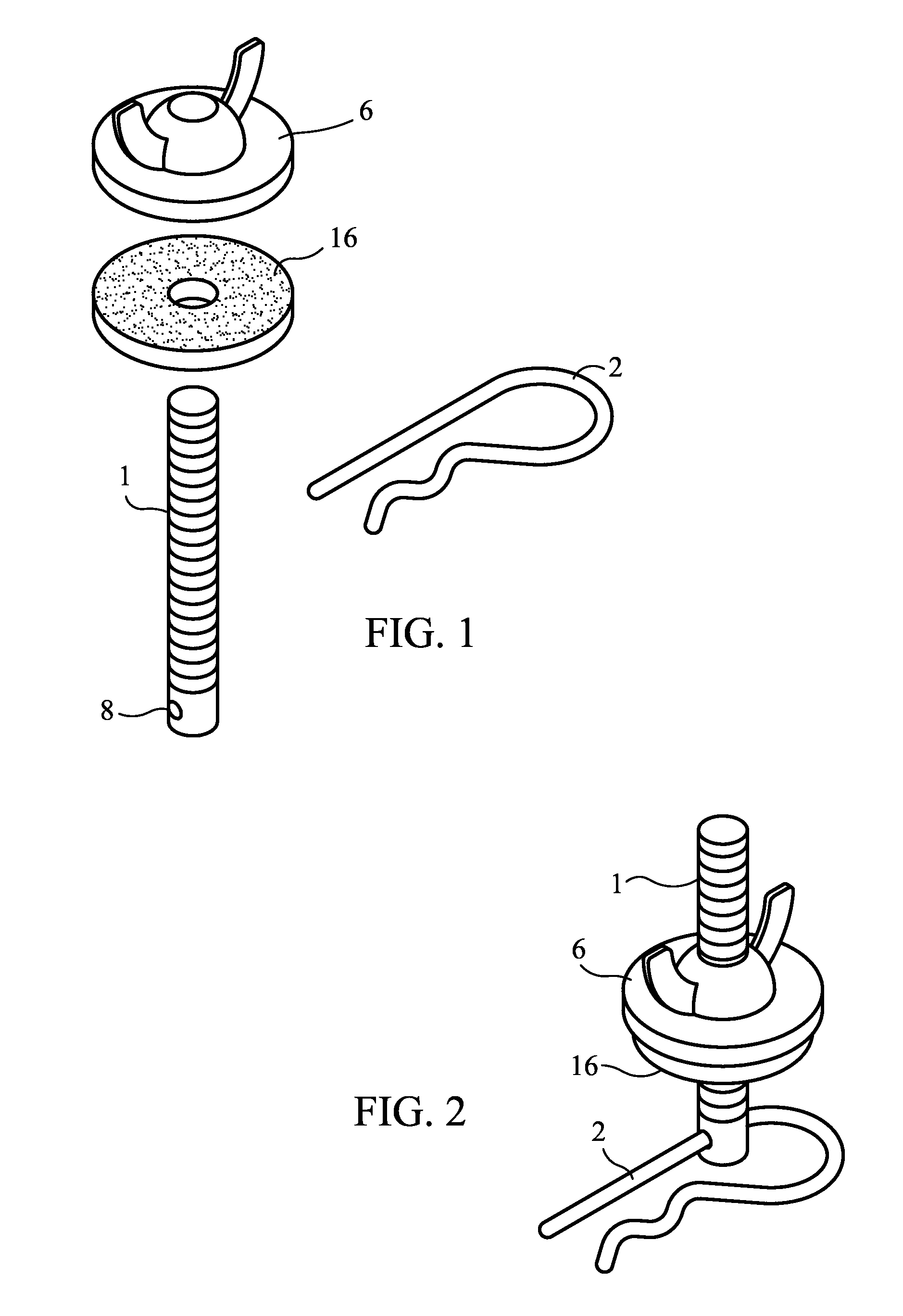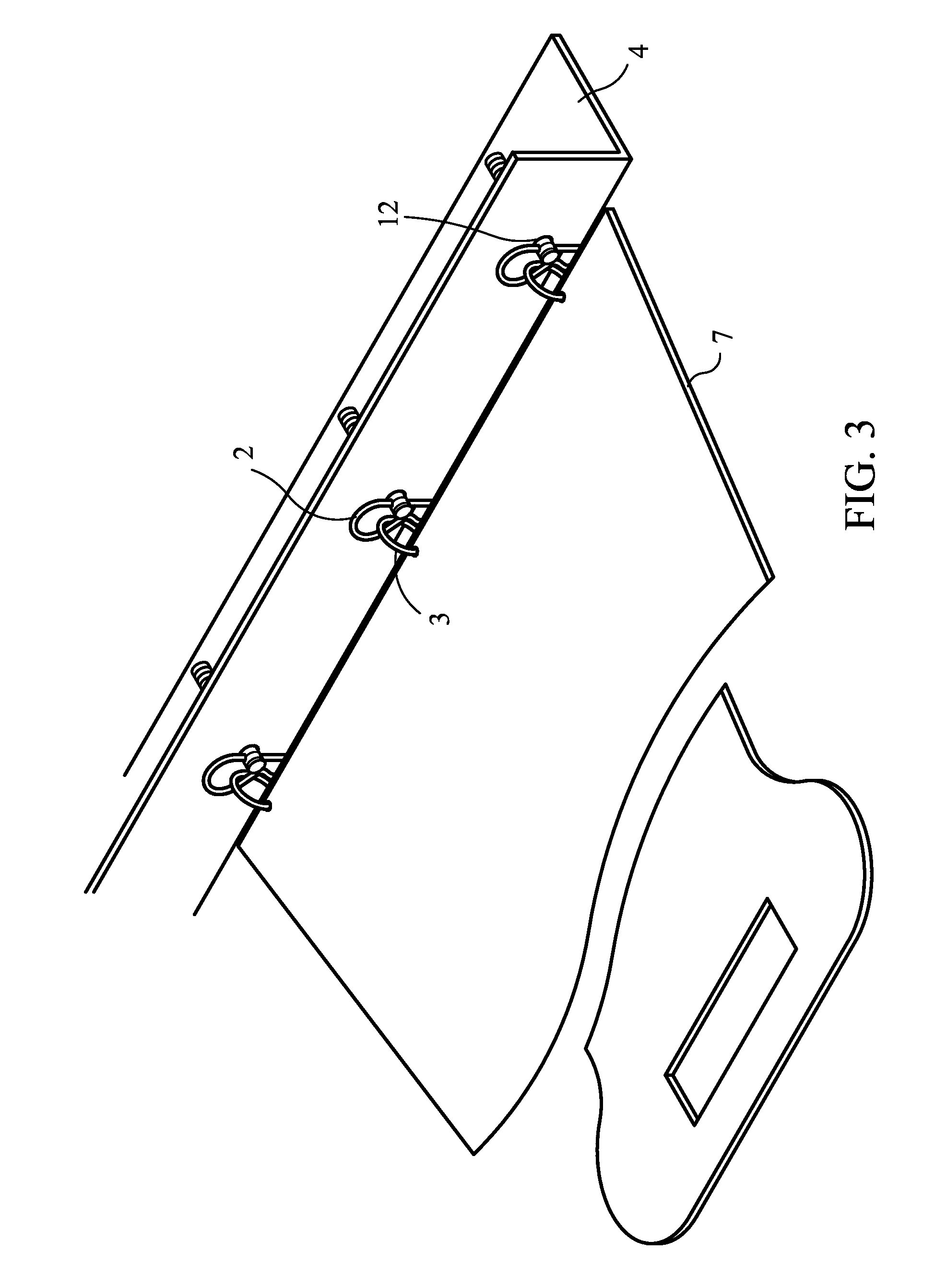System and method for attaching panels to enable removal from the inside of a structure
a technology of mounting system and panel, applied in the field of panels, can solve the problems of difficult pin extraction, and achieve the effect of quick and easy access and operation
- Summary
- Abstract
- Description
- Claims
- Application Information
AI Technical Summary
Benefits of technology
Problems solved by technology
Method used
Image
Examples
first embodiment
[0053]FIG. 1 shows the hardware components used with the first embodiment, which utilizes headless bolts 1, pins 2, neoprene washers 16 and wing nuts 6. The bolts 1 have holes 8 provided or drilled within close proximity to one end. The holes 8 are sufficiently large in diameter to accommodate the pin 2.
[0054]Hitch pin clips are preferably utilized for the pins 2, but any type of pin, for example a cotter pin or quick release pin, can be utilized, provided that the ring 3 can be attached to the pin 2, the pin 2 can pass through the hole 8 in the bolt 1, and the pin 2 can be removed from the bolt 1 by pulling on a handle (not shown), the object being to hold the bolts 1 in place and to facilitate extraction of the pins 2 and removal of the bolts 1 when desired. The pins 2 and bolts 1 are adapted to resist shear force deformation to enable disengagement of the pins 2 from the bolts 1. Likewise, the disengaging force is preferably aligned along an axis perpendicular to the axis of the ...
second embodiment
[0071]FIG. 10 shows the hardware components used with a second embodiment, which utilizes square headed bolts 20, pins 2, optional neoprene washers 16 and wing nuts 6. The bolts 20 have holes 8 provided or drilled within the square head. The holes 28 are sufficiently large in diameter to accommodate the pin 2. The square head of bolt 20 must not be larger than the opening on the front of the F-Track 13, and ideally the head should be sufficient in length and size to prevents the bolt 20 from rotating in the F track 13 thereby keeping the hole 8 aligned in place before the pin 2 is inserted. However, headless bolts with a hole in one end can also be utilized.
[0072]In this second embodiments, hitch pin clips are utilized for the pins 2, but any type of pin, for example a cotter pin or quick release pin can be utilized provided that the handle can be attached to the pin 2, the pin 2 can pass through the hole 28 in the bolt 20, and the pin 2 can be removed from the bolt 20 by pulling on...
third embodiment
[0083]FIG. 17 shows an outside view of a panel 5 attached to a structure with the assembly 69 of this The pins 2 are located on the outside of the structure, and are attached to an alternate embodiment of the handle (not shown here and shown in FIG. 9A) by lines, wires or cables (also not shown). The handle is on the inside of the structure, and the lines, wires or cables 51 are passed through a hole (not shown) in the panel 5 located above and / or below the location of the pins 2. When the pins 2 are extracted by pulling on the handle, the sleeves 61 are released and the sleeves 61 and panel 5 come off the bolts 60 so the panel can be removed.
[0084]FIGS. 18 and 19 show an alternate implementation of the third embodiment. In this alternate implementation, sleeves 66 are of a slightly shorter length as the second end of the bolts 60, and are smooth on the inside with a diameter sufficient for the sleeves 66 to fit over the second end of the bolts 60. Specifically, the length of the s...
PUM
 Login to View More
Login to View More Abstract
Description
Claims
Application Information
 Login to View More
Login to View More - R&D
- Intellectual Property
- Life Sciences
- Materials
- Tech Scout
- Unparalleled Data Quality
- Higher Quality Content
- 60% Fewer Hallucinations
Browse by: Latest US Patents, China's latest patents, Technical Efficacy Thesaurus, Application Domain, Technology Topic, Popular Technical Reports.
© 2025 PatSnap. All rights reserved.Legal|Privacy policy|Modern Slavery Act Transparency Statement|Sitemap|About US| Contact US: help@patsnap.com



